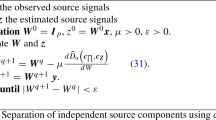Abstract
In this paper we address the problem of blind source extraction of a subset of “interesting” independent sources from a linear convolutive or instantaneous mixture. The interesting sources are those which are independent and, in a certain sense, are sparse and far away from Gaussianity. We show that in the low-noise limit and when none of the desired sources is Gaussian, the minimum entropy and cumulants based approaches can solve the problem. These criteria, with roots in Blind Deconvolution and in Projection Pursuit, will be proposed here for the simultaneous blind extraction of a group of independent sources. Then, we suggest simple algorithms which, working on the Stiefel manifold perform maximization of the proposed contrast functions.
Access this chapter
Tax calculation will be finalised at checkout
Purchases are for personal use only
Preview
Unable to display preview. Download preview PDF.
Similar content being viewed by others
References
S. Amari, “Natural gradient learning for over-and under-complete bases in ICA,” Neural Computation, vol. 11, pp. 1875–1883, 1999.
S. Amari, A. Cichocki, Y.Y. Yang, Blind Signal Separation and Extraction, chapter 3 in “Unsupervised Adaptive Filtering” Volume I, edited by S. Haykin,Wiley, 2000.
S. Amari, A. Cichocki, “Adaptive blind signal processing-neural network approaches,” Proceedings of the IEEE, vol. 86,no. 10, pp. 2026–2048, 1998.
A.J. Bell, T.J. Sejnowski, “Blind separation and blind deconvolution: An information-theoretic approach,” in ICASSP, 1995.
X-R. Cao, R-W. Liu, “General Approach to Blind Source Separation,” in IEEE Transactions on Signal Processing, vol. 44(3),pp. 562–571, March 1996.
J.F. Cardoso, “Blind signal separation: Statistical principles,” Proceedings of the IEEE, vol. 86,no. 10, pp. 2009–2025, 1998.
A. Cichocki, R. Thwonmas, S. Amari, “Sequential blind signal extraction in order specified by stochastic properties,” Electronics Letters, vol. 33,no. 1, pp. 64–65, 1997.
P. Comon, “Independent component analysis, a new concept?, ” Signal Processing, vol. 3,no. 36, pp. 287–314, 1994.
P. Comon, “Contrasts for Multichannel Blind Deconvolution,” IEEE Signal Processing Letters, vol. 3,no. 7, pp. 209–211, 1996.
T.M. Cover, J.A. Thomas, Elements of Information Theory, Wiley series in telecommunications. John Wiley, 1991.
S. Cruces, A. Cichocki, L. Castedo, “Blind source extraction in gaussian noise,” in proc. of the 2nd International Workshop on Independent Component Analysis and Blind Signal Separation (ICA’2000), Helsinki, Finland, June 2000, pp. 63–68.
N. Delfosse, P. Loubaton, “Adaptive blind separation of independent sources: A deflation approach,” Signal Processing, vol. 45, pp. 59–83, 1995.
D. Donoho, On Minimun Entropy Deconvolution, Applied Time Series Analysis II, D.F. Findley Editor, Academic Press, New York, 1981.
M. Girolami, C. Fyfe, Negentropy and kurtosis as projection pursuit indices providegeneralized ICA algorithms, pp. 752–763, Boston, MA: MIT Press, 1996.
C. Jutten, J. Herault, “Blind separation of sources, part i: An adaptive algorithm based on neuromimetic architecture,” Signal Processing, vol. 24, pp. 1–10, 1991.
J. Karhunen, E. Oja, L. Wang, R. Vigario, J. Koutsensalo, “A class of neural networks for independent component analysis,” IEEE Transactions on Neural Networks, vol. 8,no. 3, pp. 486–503, May 97.
P.J. Huber, “Projection pursuit,” Annals of Statistics, vol. 13, pp. 435–525, 1985.
A. Hyvarinen, E. Oja, “A fast fixed-point algorithm for independent component analysis,” Neural Computation, vol. 9, pp. 1483–1492, 1997.
Y. Inouye, T. Sato, “Iterative algorithms based on multistage criteria for blind deconvolution,” IEEE Transactions on Signal Processing, vol. 47,no. 6, pp. 1759–1764, June 1999.
T-P. Jung S. Makeig, A. Bell, T.J. Sejnowski, Independent Component Analysis of Electroencephalographic Data, vol. 8, pp. 145–151, M. Mozer et al., Cambridge, MA: MIT Press, 1996.
O. Shalvi, E. Weinstein, “New criteria for blind deconvolution of nonminimun phase systems (channels), ” IEEE Transactions on Information Theory, vol. 36, no.2, pp. 312–321, 1990.
J.K. Tugnait, “Identification and deconvolution of multichannel linear non-Gaussian processes using higher order statistics and inverse filter criteria,” IEEE Transactions on Signal Processing, vol. 45,no. 3, pp. 658–672, 1997.
H.H. Yang, S. Amari, “Adaptive on-line learning algorithms for blind source separation-maximum entropy and minimum mutual information,” Neural Computation, 1997.
Author information
Authors and Affiliations
Editor information
Editors and Affiliations
Rights and permissions
Copyright information
© 2001 Springer-Verlag Berlin Heidelberg
About this paper
Cite this paper
Cruces, S., Cichocki, A., Amari, Si. (2001). The Minimum Entropy and Cumulants Based Contrast Functions for Blind Source Extraction. In: Mira, J., Prieto, A. (eds) Bio-Inspired Applications of Connectionism. IWANN 2001. Lecture Notes in Computer Science, vol 2085. Springer, Berlin, Heidelberg. https://doi.org/10.1007/3-540-45723-2_95
Download citation
DOI: https://doi.org/10.1007/3-540-45723-2_95
Published:
Publisher Name: Springer, Berlin, Heidelberg
Print ISBN: 978-3-540-42237-2
Online ISBN: 978-3-540-45723-7
eBook Packages: Springer Book Archive




